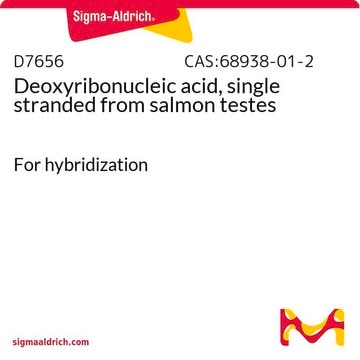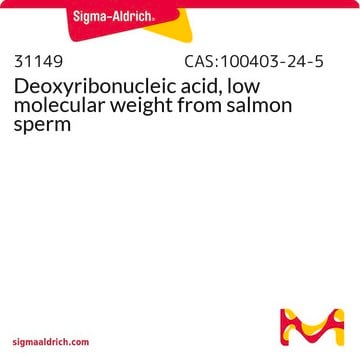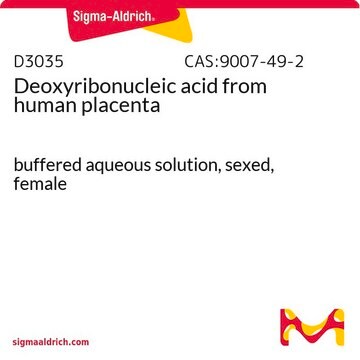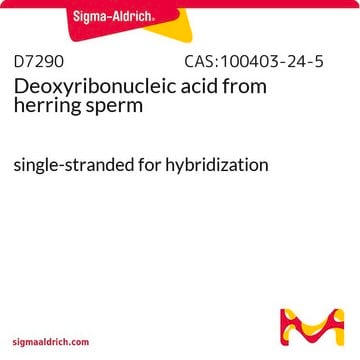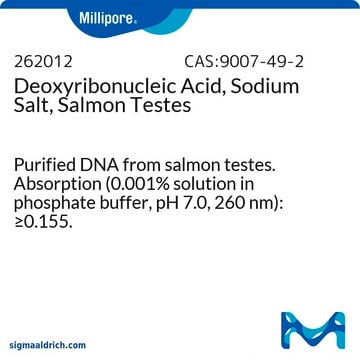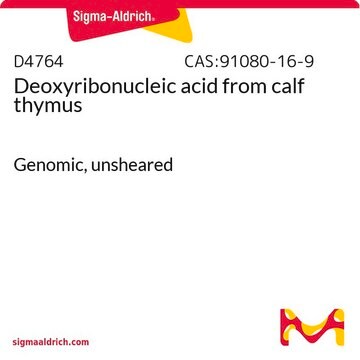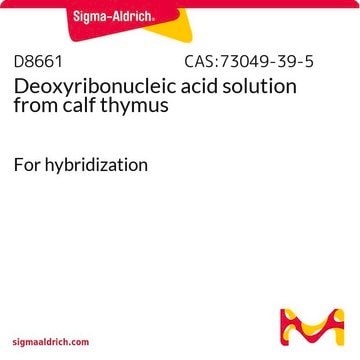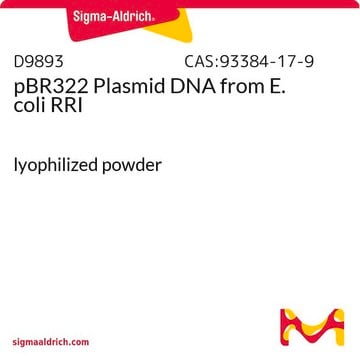D4889
Desoxyribonukleinsäure Natriumsalz aus E. coli Stamm B
Genomic, unsheared
Synonym(e):
DNA
Anmeldenzur Ansicht organisationsspezifischer und vertraglich vereinbarter Preise
Alle Fotos(1)
About This Item
CAS-Nummer:
EG-Nummer:
MDL-Nummer:
UNSPSC-Code:
41106310
eCl@ss:
32160414
NACRES:
NA.52
Empfohlene Produkte
Suchen Sie nach ähnlichen Produkten? Aufrufen Leitfaden zum Produktvergleich
Verwandte Kategorien
Allgemeine Beschreibung
Escherichia coli strain B is most widely studied DNA after k-12. The genomes of E coli strain B and k-12 show differences in the IS sequence elements. Strain B have B-islands and express O-specific side-chain LPS. The product is unsheared genomic DNA.
Spezifität
50% GC; Tm = 90.5 °C
Anwendung
The DNAs are particularly useful for genomic analysis, including PCR, library construction in bacteriophage λ, and in heterologous pre-hybridization and hybridization protocols.
Deoxyribonucleic acid sodium salt from Escherichia coli strain B has been used for:
Deoxyribonucleic acid sodium salt from Escherichia coli strain B has been used for:
- PCR reactions of genomic DNA of Gardnerella vaginalis
- nick translation and radiolabeling of dNTP
- generating standard curve for 16S rDNA quantification
- transfecting neutrophils
- testing the extraction methods
Einheitendefinition
One unit will yield an A260 of 1.0 in 1.0 ml of 1 mM Tris-HCl, pH 7.5, with 1 mM NaCl and 1 mM EDTA (1 cm light path).
Angaben zur Herstellung
Purified by anion exchange chromatography, dialyzed against a solution of 1 mM sodium chloride, 1 mM EDTA and 1 mM Trizma HCl, pH 7.5 and lyophilized at a concentration of approx. 2 units per mL. Approx. 20 A260 units per mg DNA. % GC is the percentage of G/C base pairs. Tm is the temperature at the midpoint of the thermal denaturation profile.
Hinweis zur Analyse
Analyzed by gel electrophoresis and visualization after ethidium bromide staining, with single predominant band of 45 kB or greater.
Sonstige Hinweise
DNA in solution will reanneal on standing at room temperature so it is recommended to boil the solution for 10 minutes and then cool on ice for at least 5 minutes prior to use.
Ähnliches Produkt
Produkt-Nr.
Beschreibung
Preisangaben
Lagerklassenschlüssel
11 - Combustible Solids
WGK
WGK 3
Flammpunkt (°F)
Not applicable
Flammpunkt (°C)
Not applicable
Persönliche Schutzausrüstung
Eyeshields, Gloves, type N95 (US)
Analysenzertifikate (COA)
Suchen Sie nach Analysenzertifikate (COA), indem Sie die Lot-/Chargennummer des Produkts eingeben. Lot- und Chargennummern sind auf dem Produktetikett hinter den Wörtern ‘Lot’ oder ‘Batch’ (Lot oder Charge) zu finden.
Besitzen Sie dieses Produkt bereits?
In der Dokumentenbibliothek finden Sie die Dokumentation zu den Produkten, die Sie kürzlich erworben haben.
Kunden haben sich ebenfalls angesehen
Johan Sukweenadhi et al.
Antonie van Leeuwenhoek, 106(5), 935-945 (2014-08-30)
Strain DCY84(T), a Gram-stain positive, rod-shaped, aerobic, spore-forming bacterium, motile by means of peritrichous flagella, was isolated from humus soil from Yongin forest in Gyeonggi province, South Korea. Strain DCY84(T) shared the highest sequence similarity with Paenibacillus barengoltzii KACC 15270(T)
Rudolph Spangler et al.
PloS one, 4(9), e7010-e7010 (2009-09-16)
PCR in principle can detect a single target molecule in a reaction mixture. Contaminating bacterial DNA in reagents creates a practical limit on the use of PCR to detect dilute bacterial DNA in environmental or public health samples. The most
Mohamed El-Agamy Farh et al.
Journal of microbiology (Seoul, Korea), 55(10), 767-774 (2017-09-29)
Gram-staining-negative, uniflagellated, rod-shaped, designated as DCY110
Genomic comparisons among Escherichia coli strains B, K-12, and O157: H7 using IS elements as molecular markers
Schneider D, et al.
BMC Microbiology, 2(1), 18-18 (2002)
Yue Huo et al.
Current microbiology, 76(1), 22-28 (2018-11-02)
A Gram-positive bacterium (DCY118T) was isolated from ginseng-cultivated soil in Gochang-gun, Republic of Korea. This isolate was assigned to the genus Ornithinimicrobium and is closely related to Ornithinimicrobium kibberense K22-20T (98.8%), O. pekingense DSM 21552T (98.5%), O. algicola JC311T (98.2%)
Unser Team von Wissenschaftlern verfügt über Erfahrung in allen Forschungsbereichen einschließlich Life Science, Materialwissenschaften, chemischer Synthese, Chromatographie, Analytik und vielen mehr..
Setzen Sie sich mit dem technischen Dienst in Verbindung.
